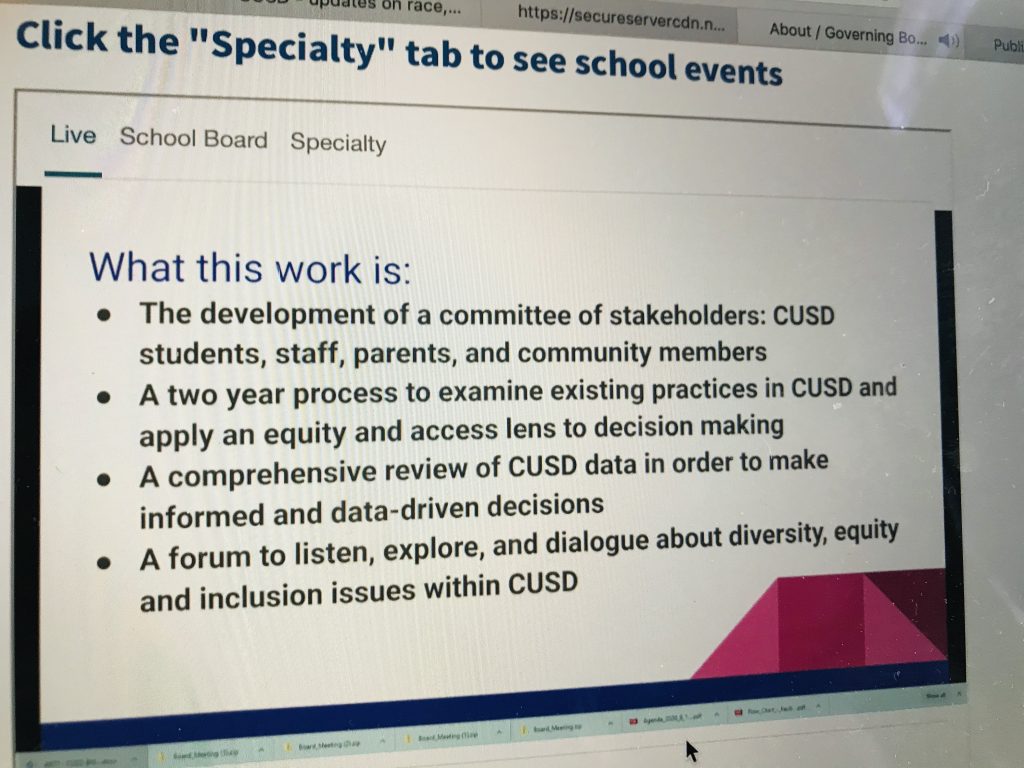The regularly-scheduled CUSD board meeting was held at district offices on Thursday, August 13, at 4pm. The four-hour long meeting was held indoors, where most board members wore masks, and protesters from InclusioNado—a local group dedicated to ending racism in Coronado–chanted outside, demanding equity for students of color.
At the meeting, CUSD Board members unveiled the proposed Equity Action Plan—a two year plan with a phased approach. Key outcomes included the immediate addition of disciplinary action for racial slurs, the formation of an equity committee, and the implementation of surveys and a forum to gather data from parents, teachers and students.
Much controversy has surrounded the announcement of a school equity plan, and Superintendent Karl Mueller addressed these concerns in his opening remarks.
“Our student services report has garnered a lot of attention, and rightfully so,” said Mueller. “Unfortunately, there is a lot of misinformation circulating as to what our equity work is, and what it is not. I’m relieved that our community will hear directly from our staff on our objectives regarding this work.”
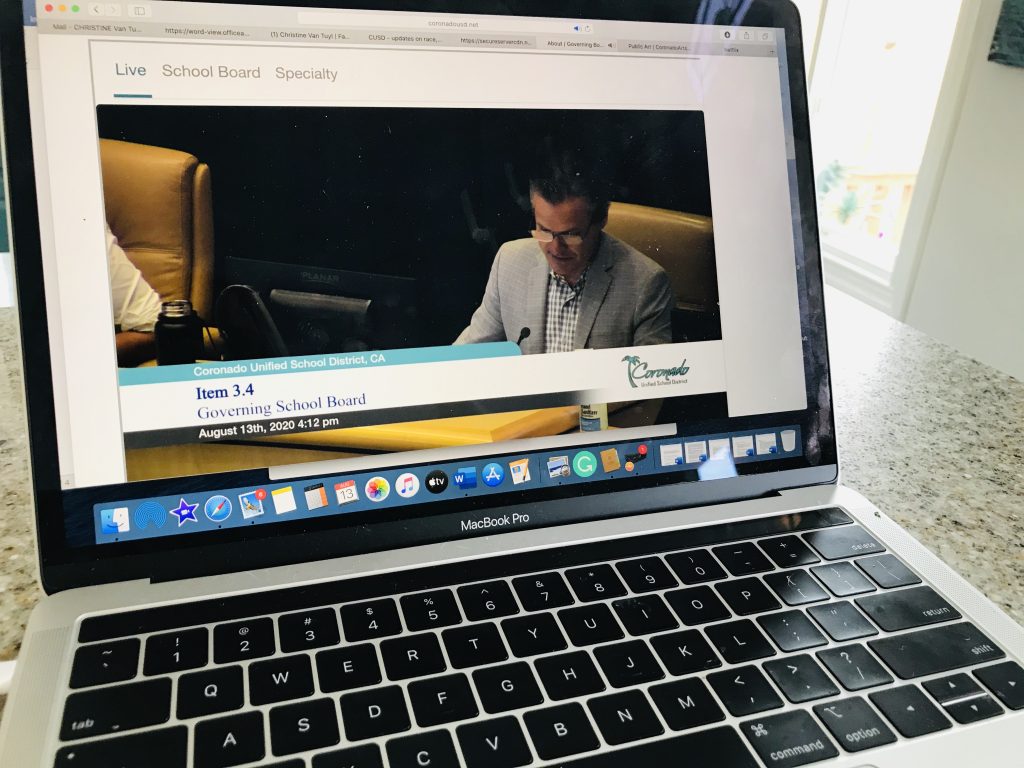
Earlier in the week, InclusioNado sent out a response to a report included in the board meeting agenda. (The report, from the California School Boards Association, serves as a brief to outline the issue of educational inequity.)
InclusioNado maintained that the board was not doing enough to address the use of prolific racial slurs, the Anglo-centric curriculum, the lack of diversity among the teaching staff and the lack of teacher training on bias and racism.
Mueller urged community members to hear from the CUSD staff in regards to their local goals and initiatives, separate from the CSBA’s policy language.
“I’m hopeful that, when individuals give us a chance to respond to students’ needs, they will listen,” said Mueller. “Our commitment to connect, challenge and champion every child, every day, [hasn’t] and will never waiver.”
Before the board addressed the plan, they opened the floor to public comments. Many citizens shared concerns that racism in Coronado schools warranted urgent attention. Some citizens advocated for stronger consequences for the use of racial slurs, a more ethnically-minded curriculum, and a means to ensure a more diverse staff and student body. Others demanded an external diversity consultant to help formulate a workable and effective equity plan.
“Our students of color have tolerated slurs and harassment for too long,” said Roger Donaldson, in an email to the CUSD Board. “Show the students you care with your actions, and not with your committees made up of untrained white people.”
“Some changes will take time, but there are also meaningful changes (ban racial slurs, revise disciplinary policy, assign books by authors of color) that can we implement in the new school year,” said Abby Berk in an email. “We owe it to our students to make these beneficial changes starting now.”
“People may say there’s not a problem here in Coronado, but there is,” said Ruthie Grant-Williams in an email. “People need to be held accountable for their actions no matter what, and they need to be educated.”
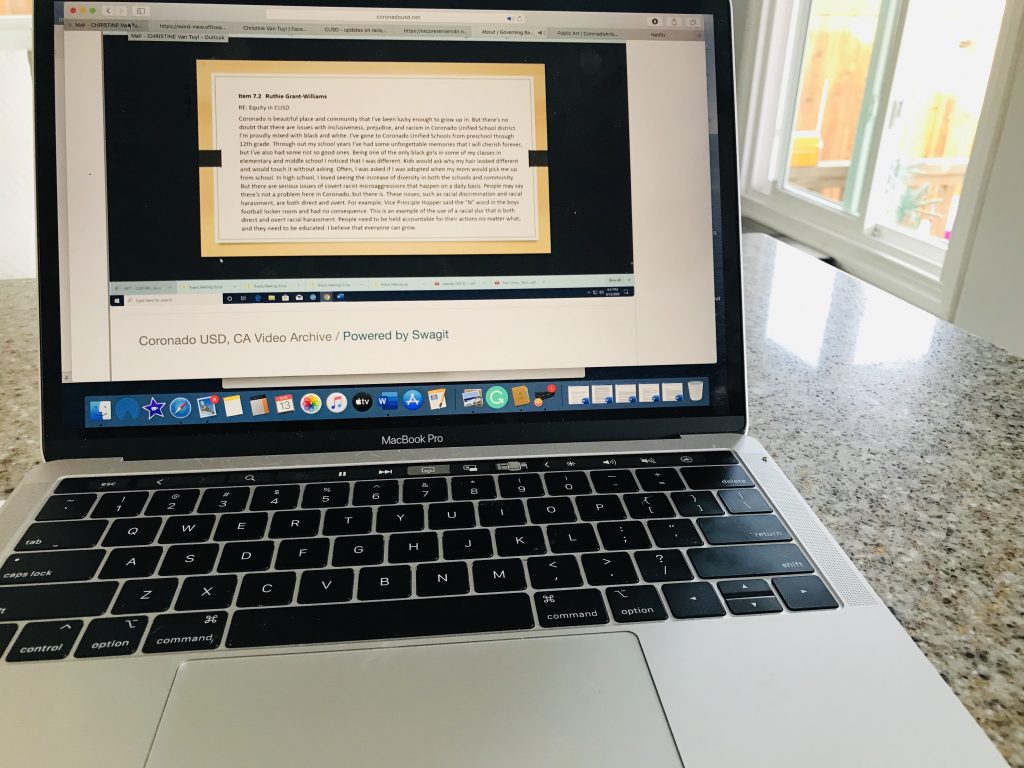
Other parents and community members expressed concern over rushing to adopt a new curriculum without community or parent input. Some even said racism is not a problem in Coronado. Others argued that the focus should be on reopening schools, not an equity plan.
“I can see we are rushing to change school policy fast and without notice or input from the parents,” said parent Andrew Smith in an email to the board. “It seems like politics are being played and we will not stand idle and wait to see if, or how, our children will be damaged by it.”
“There should be no change in the curriculum this year, especially with online classes and children not able to get regular one-on-one classroom,” said Eileen Hannegan Panek in an email. “The children are under enough pressure. Just teach them…not BLM brainwash!”
“Parental involvement in addressing change is of upmost importance,” said Theresa Murray in an email. “Where is the empirical evidence to support investing already scarce resources in light of other priorities such as opening our schools?”
Another parent left an anonymous voicemail, concerned over the introduction of a new curriculum.
“I don’t appreciate any school district trying to pull any kind of shenanigans when it comes to adding race-related curriculum that isn’t voted upon,” the parent said in the voicemail. “I truly do not believe that there is a racism issue within our community. I have never seen or felt it.”
The proposed Equity Action Plan was then presented by Niamh Foley, Director of Student Services with CUSD.
“There seems to be a lot of misconceptions and fears about what this plan is, and what it is not,” said Foley. “First and foremost, this is the development of a committee of CUSD students, staff, parents, and community members. What we are proposing today is to develop this group. It will be a two-year process to examine our existing processes at CUSD, and apply an equity and access lens to our decision making.”
Foley explained the plan will include a comprehensive review of CUSD data in order to make informed and data-driven decisions, and a forum to listen, explore, and dialogue about diversity and inclusion issues of CUSD. She said the plan is not a complete overhaul of CUSD policies and/or practices, or a shift from core values.
“It will not interfere with a safe return to school due to COVID-19, and it’s not a ‘quick fix’ or a ‘checking of the box,’” said Foley.
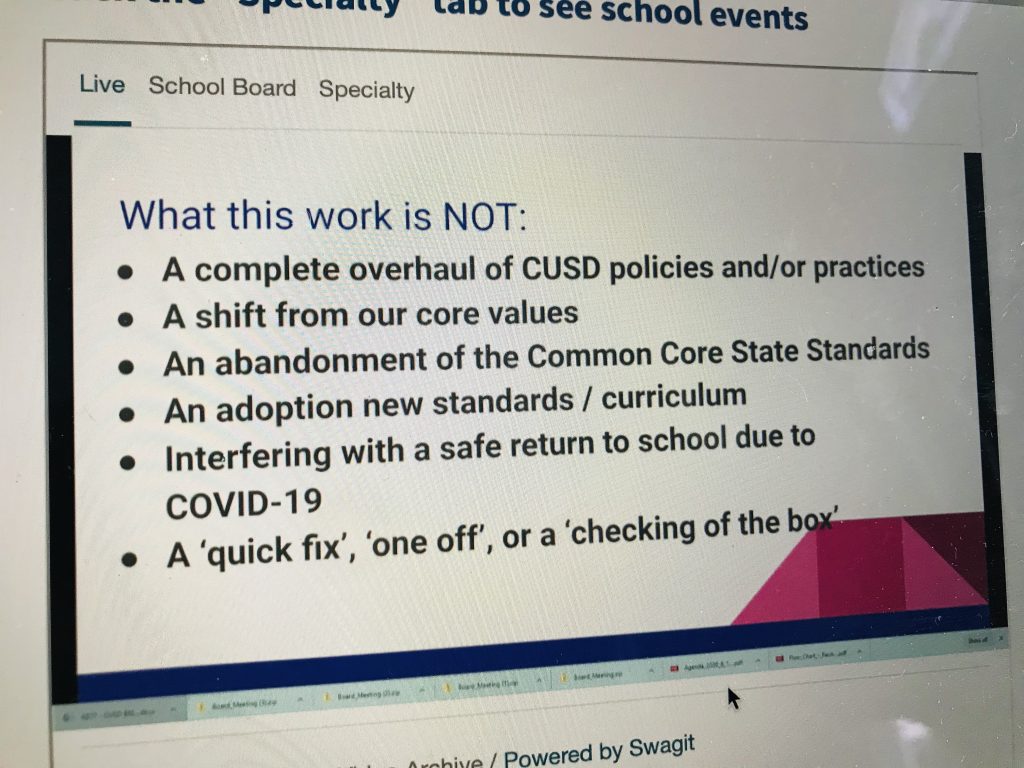 Some of the immediate action items include assembling a committee of stakeholders dedicated to examining equity in CUSD, a survey and thought exchange, and establishing a forum in order to share experience and perspectives.
Some of the immediate action items include assembling a committee of stakeholders dedicated to examining equity in CUSD, a survey and thought exchange, and establishing a forum in order to share experience and perspectives.
Board member Helen Anderson-Cruz said it would be important to be fair in selecting members for the committee.
“I agree all views should be heard, and in our community we have so many people who are anxious to be involved. So, if we’re talking about equity, there should be equity in the process of selecting who gets to be on the committee,” said Anderson-Cruz.
One of the immediate action items added the use of biased language (including racial slurs) to the Discipline Action Guide.
Board member Lee Pontes underscored the urgent need to make this change.
“We need to immediately ensure that when kids come back to school, they are safe and respected,” said Pontes. “I think the change to the Discipline Action Guide will certainly provide more guidance to teachers, staff, and principals as to when to bring action.”
Other long-term action items include reviewing current curriculum and instructional materials to ensure they accurately reflect diverse perspectives, a review of HR policies related to the employment of a diverse staff, and professional development on culturally responsive instructional practices.
Foley said that the district would seek a partnership with the San Diego County Office of Education to help provide leadership and coaching for district equity teams. At some point, through the result of input from the equity committee, other outside sources or consultants may be utilized, according to Mueller.
When it comes to demographics, Pontes pointed out there’s no easy fix.
“The diversity issue that we have is, a great deal, due to our demographics,” said Pontes. “Coronado is what Coronado is. There has been discussion about using inter district transfers (IDTs) to bring in a more diverse student body, but it’s not as easy as you might think.”
It was explained that there are logistical problems when it comes to bringing in IDTs, with the goal of creating a more diverse student population.
“If a family lives outside of Coronado, and chooses to attend school here, they can submit an application,” said Foley. “But there is no identifying information on that application that would identify a student’s race or ethnicity. That’s by law, and it’s the same across the county.”
So the district can change the number of IDTs, but it won’t necessarily change the demographic, asserted Pontes. CUSD will have to get creative if it is serious about diversifying the schools.
“I don’t want to give anyone the wrong impression, I would love to have a more diverse student population. But it is very difficult for us to do that,” said Pontes. “Maybe we can partner up with a school that has a more diverse demographic, and do some sort of exchange and increase diversity in other creative ways.”
The district runs into a similar issue, according to Foley, should they try to obtain a more diverse staff. When the school is hiring for a position, it’s based on the credential the person holds for the position, and the district would have no way of knowing the applicant’s race, ethnicity, or gender when sorting through applications.
Another hot topic: the concern that the BLM curriculum will be incorporated into teachings at Coronado schools.
Board members said that, although the BLM curriculum is available to teachers (as it is shared on the National Education Association website and California Teachers Association website), it is not being adopted by Coronado schools.
“Just to clarify, the Coronado School District is not adopting the curriculum of a political organization (BLM),” asserted Board Member Esther Valdes-Clayton.
“We take a lot of care in this community when we bring in new curriculum here,” said Board member Maria Simon. “Any changes would never happen overnight.”
Mueller said that he is glad the board can take immediate action to fight racism.
“Anytime an educator or a parent hears that there are students within our school community that don’t feel safe, don’t feel valued, or who don’t feel respected, we do feel a sense of urgency, of ‘drop everything’ and what can we can do to listen and respond in a way that will at least address the information that has been brought forward,” said Mueller. “I appreciate that we are given the authority to move forward in a phased approach, where we have a two year plan, but there are some things we can introduce immediately…in our hallways and in our zoom chatrooms while school resumes in August.”
As mandated by the state, Coronado schools will reopen with virtual learning on August 27th, unless they meet safe reopening guidelines. The distance learning program for fall 2020 will be called CUSD Bridge: Connecting educators, students and families in distance learning.
“CUSD is preparing to open school on August, 27 from a distance,” said Dr. Megan Battle in her report. “As San Diego is currently still on the watch list, we have been preparing schedules and plans for each school site in collaboration with the Fall Task Force and considering feedback from our shareholder community and provided from each town hall meeting held in July.”
 As Dr. Battle explained, CUSD Bridge is different than the distance learning program of the spring. As shared during each of the town hall meetings, Bridge will consist of a combination of daily, live synchronous instruction and rigorous asynchronous (independent) learning experiences.
As Dr. Battle explained, CUSD Bridge is different than the distance learning program of the spring. As shared during each of the town hall meetings, Bridge will consist of a combination of daily, live synchronous instruction and rigorous asynchronous (independent) learning experiences.
Most live instruction, socio-emotional learning and classwork occurs in the morning, while the afternoon is geared towards support time, drop ins, small groups, and special education services. Dr. Battle shared that the school is providing professional services to teachers on creating fair assessments for students.
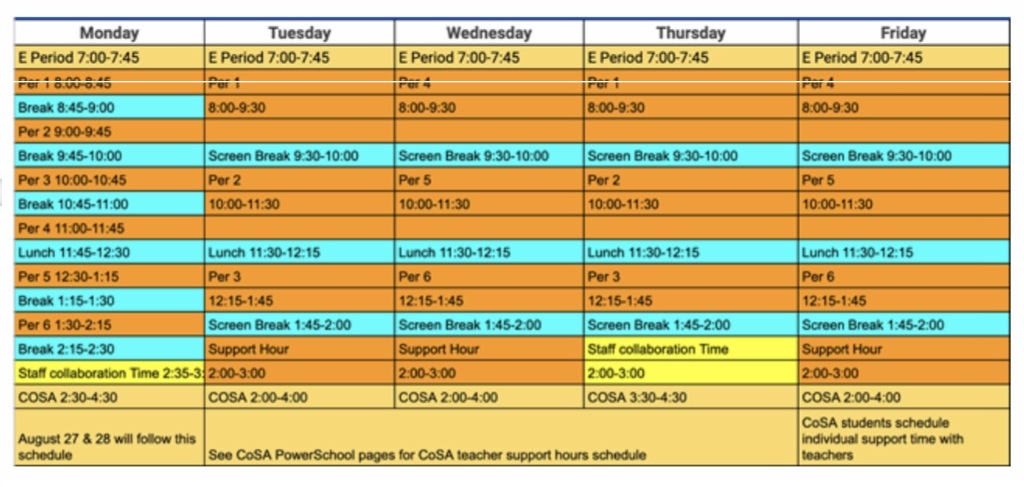
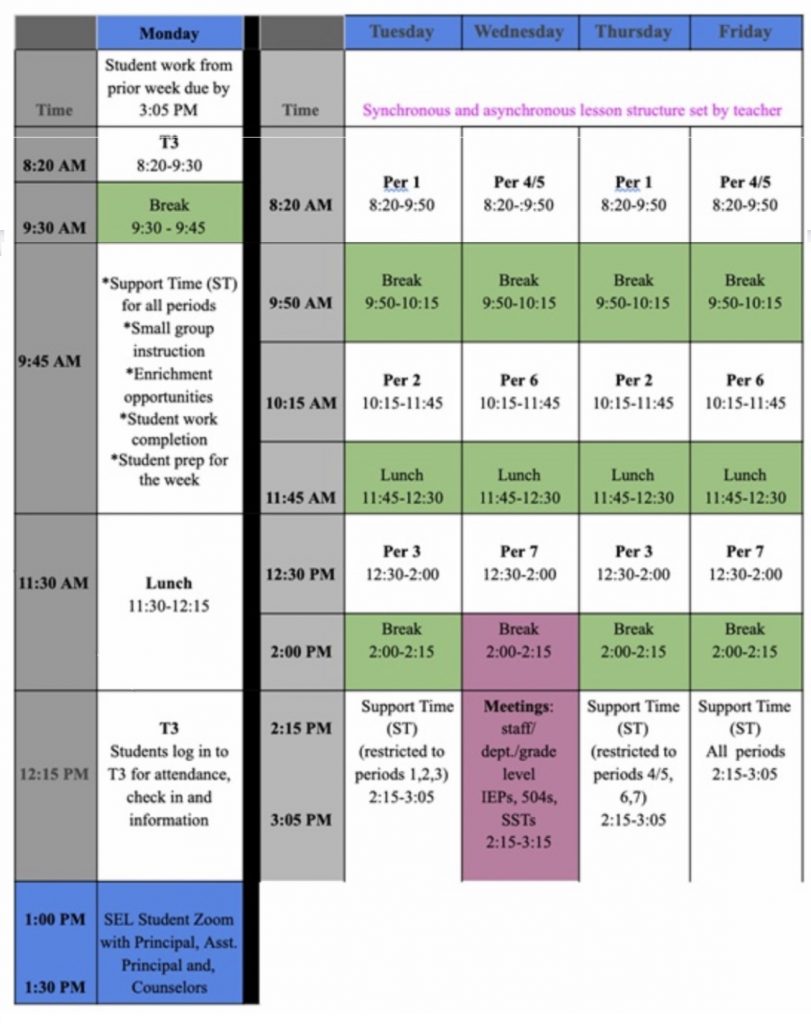
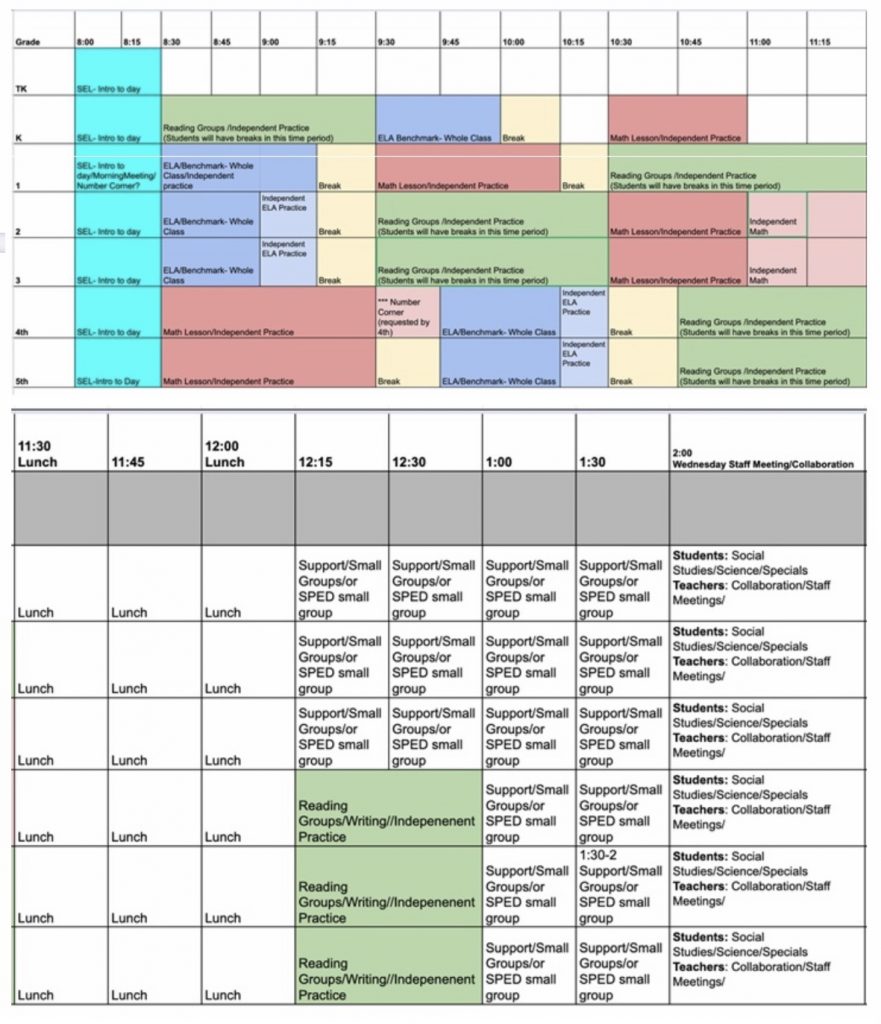
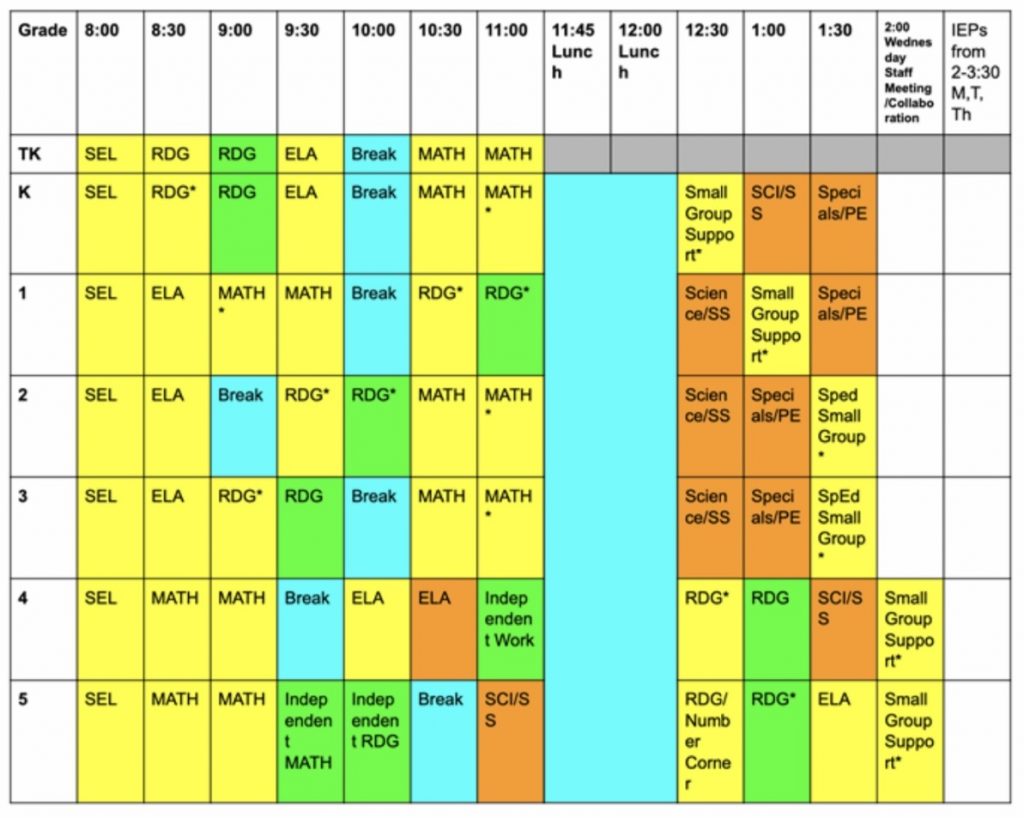
Dr. Battle addressed a question about “pods,” where groups of parents are planning to get their kids together with a teacher or “pod leader” to help administer group teaching. She said she thinks pods are a “wonderful” idea, but parents have to remember that only they–as parents- have educational rights to communicate with teachers. (The pod leaders will not be able to do so.)
Mueller reiterated that as soon as schools are able to safely reopen, they will do so. He said the waiver for an early reopening for the elementary schools has been obtained and filled out.
“We have downloaded the waiver, we have information ready to submit and to apply for this waiver,” said Mueller. “Our commitment to our students and to our community is to keep options open and remain flexible.”
Mueller expressed a sentiment that a virtual learning re-opening could open new possibilities to learning, and isn’t necessarily a bad thing.
“We view the reopening in a virtual environment, not as a reaction to an emergency, but as an opportunity to leverage this time to find new and creative ways to challenge, connect and champion our learners,” said Mueller. “I believe with our amazing faculty and staff we can use this time and support a fidelity of new curriculum, new assessment, in alignment of expectations and the sharing of best practices. So I am looking forward to viewing this opportunity through a positive lens, not necessarily a response or a reaction to the pandemic.”
Keep your eye out for more information from the district on the new Bridge program, and more back-to-school information.




